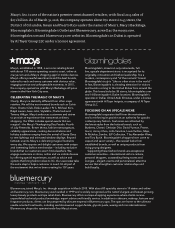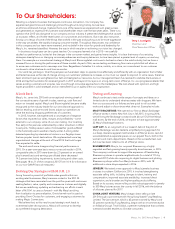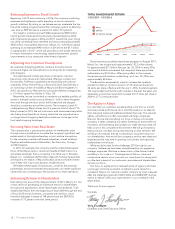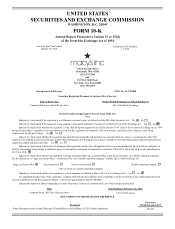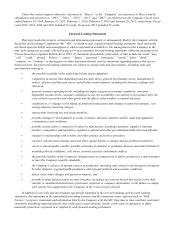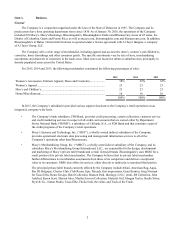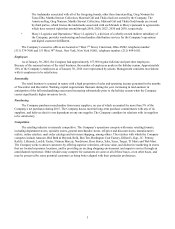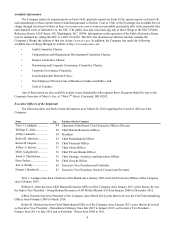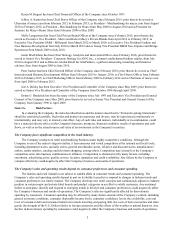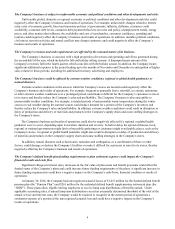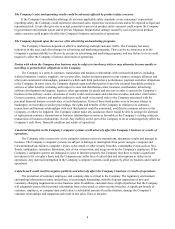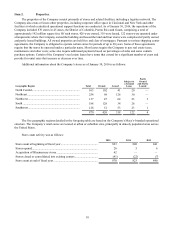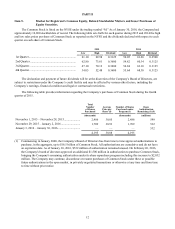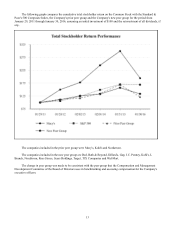Macy's 2015 Annual Report Download - page 10
Download and view the complete annual report
Please find page 10 of the 2015 Macy's annual report below. You can navigate through the pages in the report by either clicking on the pages listed below, or by using the keyword search tool below to find specific information within the annual report.5
Karen M. Hoguet has been Chief Financial Officer of the Company since October 1997.
Jeffrey A. Kantor has been Chief Stores Officer of the Company since February 2015; prior thereto he served as
Chairman of macys.com from February 2012 to February 2015; as President - Merchandising for macys.com from August
2010 to February 2012; as President - Merchandising for Home from May 2009 to August 2010 and as President for
furniture for Macy’s Home Store from February 2006 to May 2009.
Molly Langenstein has been Chief Private Brand Officer of the Company since February 2015; prior thereto she
served as Executive Vice President - Men’s and Kids at Macy’s Private Brands from April 2014 to February 2015; as
Executive Vice President GMM - Millennial from March 2012 to March 2014; as Executive Vice President Fashion and
New Business Development from July 2010 to March 2012 and as Group Vice President DMM Neo, Impulse and Bridge
Sportswear from March 2009 to July 2010.
Justin MacFarlane has been Chief Strategy, Analytics and Innovation Officer since February 2016; prior thereto he
served as Senior Vice President - Corporate Strategy for ANN, Inc., a women's multichannel fashion retailer, from July
2010 to August 2015 and as Director, Global Retail for AlixPartners, a global restructuring consulting and financial
advisory firm, from August 2006 to June 2010.
Peter Sachse has been Chief Growth Officer of the Company since February 2016; prior thereto he served as Chief
Innovation and Business Development Officer from February 2015 to January 2016; as Chief Stores Officer from February
2012 to February 2015; as Chief Marketing Officer from February 2009 to February 2012 and as Chairman of macys.com
from April 2006 to February 2012.
Joel A. Belsky has been Executive Vice President and Controller of the Company since May 2009; prior thereto he
served as Senior Vice President and Controller of the Company from October 1996 through April 2009.
Dennis J. Broderick has been Secretary of the Company since July 1993 and Executive Vice President and General
Counsel of the Company since May 2009; prior thereto he served as Senior Vice President and General Counsel of the
Company from January 1990 to April 2009.
Item 1A. Risk Factors.
In evaluating the Company, the risks described below and the matters described in “Forward-Looking Statements”
should be considered carefully. Such risks and matters are numerous and diverse, may be experienced continuously or
intermittently, and may vary in intensity and effect. Any of such risks and matters, individually or in combination, could
have a material adverse effect on the Company's business, prospects, financial condition, results of operations and cash
flows, as well as on the attractiveness and value of an investment in the Company's securities.
The Company faces significant competition in the retail industry.
The Company conducts its retail merchandising business under highly competitive conditions. Although the
Company is one of the nation’s largest retailers, it has numerous and varied competitors at the national and local levels,
including department stores, specialty stores, general merchandise stores, off-price and discount stores, manufacturers’
outlets, online retailers, catalogs and television shopping, among others. Competition may intensify as the Company’s
competitors enter into business combinations or alliances. Competition is characterized by many factors, including
assortment, advertising, price, quality, service, location, reputation and credit availability. Any failure by the Company to
compete effectively could negatively affect the Company's business and results of operations.
The Company’s sales and operating results depend on consumer preferences and consumer spending.
The fashion and retail industries are subject to sudden shifts in consumer trends and consumer spending. The
Company’s sales and operating results depend in part on its ability to predict or respond to changes in fashion trends and
consumer preferences in a timely manner. The Company develops new retail concepts and continuously adjusts its industry
position in certain major and private-label brands and product categories in an effort to satisfy customers. Any sustained
failure to anticipate, identify and respond to emerging trends in lifestyle and consumer preferences could negatively affect
the Company’s business and results of operations. The Company’s sales are significantly affected by discretionary
spending by consumers. Consumer spending may be affected by many factors outside of the Company’s control, including
general economic conditions, consumer disposable income levels, consumer confidence levels, the availability, cost and
level of consumer debt and consumer behaviors towards incurring and paying debt, the costs of basic necessities and other
goods, the strength of the U.S. Dollar relative to foreign currencies and the effects of the weather or natural disasters. Any
decline in discretionary spending by consumers could negatively affect the Company's business and results of operations.


